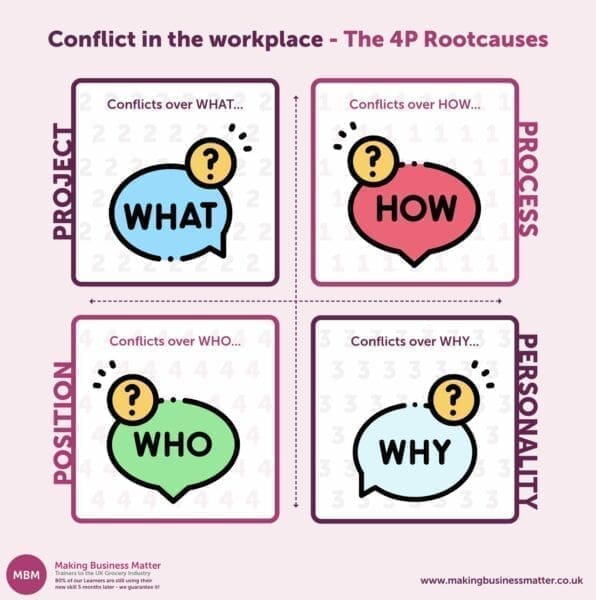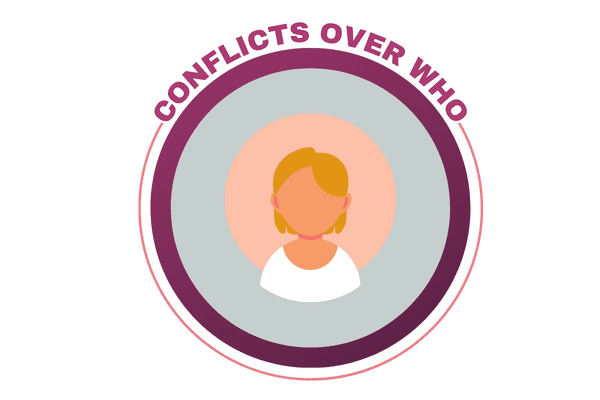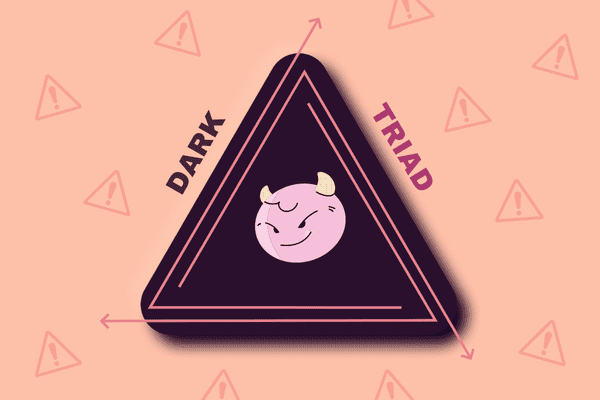Did You Know 85% of People Experience Conflicts at Work?
Even more, 49% of causes of conflicts at the workplace are directly tied to personality traits, egos, and bias.
These conflicts can lead to delays, mistakes, and reduced productivity, and can also cause damage to relationships, and morale in the workplace.
Personality conflicts can arise when individuals have different personalities, communication styles, work habits, or values.
Egos can also play a role in conflicts, as individuals may need to be in control or to be seen as experts.
Bias can also contribute to conflicts, as individuals may have unconscious biases that influence their interactions with others.
There are four root causes of conflicts at work. These are the 4P Root-causes.
The model is inspired by transactional analysis of psychology and the work of Amy Gallo, who is an author and speaker on the topics of communication and conflict resolution.

The 4P Rootacauses are:
1. Project Conflicts: CONFLICT OVER WHAT
These conflicts arise when individuals or teams disagree about WHAT the project and action steps are and in which number and order the project should be done.
2. Process Conflicts: CONFLICT OVER HOW
These conflicts arise when individuals or teams disagree about HOW to complete a task or HOW to make decisions or other necessary process steps.
3. Position Conflicts: CONFLICT OVER WHO
These conflicts arise when individuals or teams have competing needs over WHO will get the power position, goals, or level of a higher status.
4. Personality Conflicts: CONFLICT OVER WHY
These conflicts arise when individuals or teams have difficulty understanding one another and the reason WHY they behave as they do.
Conflicts in the workplace can overlap and have multiple causes. It refers to a struggle or opposition between two or more parties with conflicting interests, goals, values, or needs. Conflicts can be internal, within an individual, or external, between individuals, groups, or organisations.
The 4P is simply a model to make a quick overview to understand people’s behaviour and can not alone explain the complex dynamic of conflicts.
The number from global research done by Society for Human Resource Management (SHRM) shows that the conflict at the workplace needs to be addressed. See the stats and connected issues below:
- 27% state that they have faced or experienced direct personal attacks at work due to conflicts.
- 25% state that they have witnessed people around them in the workplace falling ill due to conflicts.
- 29% state they constantly have conflicts in their workplace.
- The survey also shows that 9% of all projects have been stopped and never been fulfilled directly caused by conflicts.
Another survey carried out by the CIPD (Champion Better Work and working lives) shows that conflicts in the workplace cause stress for 43% of all employments. 39% of those who took part in the survey say they become so unmotivated that they simply lose interest and commitment to do their job for the upcoming future.
Let us take a deeper look at the 4P root causes of conflicts in the workplace.
1 – PROJECT – CONFLICTS OVER WHAT

These conflicts arise when individuals or teams disagree about WHAT to do. Some of the common causes include:
1. Disagreements on the Best Approach to Take:
Different team members may have different ideas about the best way to complete a task, leading to disagreements about which approach to take.
2. Disagreements on the Use of Resources:
Team members may have different opinions on what kind of resources (such as time, money, or personnel) should be allocated to complete the task, leading to disagreements on what to do next.
3. Disagreements on the Level of Detail or Quality Required:
Some team members may want to focus on completing the task quickly, while others may want to put more emphasis on ensuring a high level of detail or quality.
4. Disagreements on the Level of Collaboration Required:
Some team members may prefer to work independently, while others may want to work more collaboratively.
5. Disagreements on the Schedule or Deadline:
Team members may have different ideas about time management and what is necessary for time management.
6. Disagreements on the Level of Risk Acceptable:
Some team members may be more risk-averse and may want to take a more conservative approach, while others may be more willing to take risks.
7. Lack of Clear Instructions or Guidelines:
When instructions or guidelines for a task or job are not clear, team members may have different interpretations of what needs to be done, leading to confusion and mistakes.
8. Lack of Resources:
Conflicts can occur when the team doesn’t have the necessary resources, such as equipment, materials, or funding, to complete the job.
9. Lack of Skills or Experience:
Conflicts can occur when team members do not have the necessary skills or experience to complete the job correctly
10. Poor Planning:
Conflicts can occur when there is poor planning, such as a lack of timelines, milestones, or clear objectives.
2. PROCESS- CONFLICT OVER HOW

Conflict and disagreement in the process of working can arise when individuals or teams have different ideas or opinions about HOW to complete a task or HOW to run the process.
This type of conflict is often referred to as “process conflict.” Some common causes of process conflict at the workplace include:
1. Different Work Styles:
People may have different ways of approaching their work, which can lead to conflicts over the best way to start and complete a task.
2. Different Levels of Expertise or Experience:
Individuals or teams may have different levels of expertise or experience, which can lead to conflicts over the best way to do the work.
3. Different Priorities:
People may have different priorities, which can lead to conflicts over how to allocate time and resources.
4. Different Expectations:
Individuals or teams may have different expectations about how the work should be done, which can lead to conflicts over the final outcome.
5. Different Problem-solving Approaches:
Individuals or teams may have different ways of solving problems, which can lead to conflicts over the best solution to a problem.
6. Resistance to Change:
People may resist changes to established processes, which can lead to conflicts over how to implement new processes.
7. Differences in Opinion or Perspective:
People may have different ideas on how to approach a problem or complete a task, leading to conflicts.
8. Limited Resources:
Conflicts may also occur when team members are competing for limited resources, such as budget or time.
9. Lack of Information:
People may not have all of the information they need to make informed decisions about how to approach the work.
10. Lack of Clear Instructions or Guidelines:
If individuals or teams are not provided with clear instructions or guidelines, they may have different ideas about how to approach a task.
3. POSITION – CONFLICT OVER WHO

Power position conflicts occur when individuals or groups within an organisation are vying for control or influence over WHO take decisions and WHO controls the resources and position.
These conflicts can stem from differences in job titles, responsibilities, or levels of authority, as well as from differences in personal ambition, experience, and expertise.
Power position conflicts can manifest in various ways, such as competition for who will have the most influence and the best position.
Some common causes of power imbalances at the workplace include
1. Competition for Promotions or Advancements:
When multiple individuals or teams are competing for the same promotion or advancement, it can create tension and conflict.
2. Differences in Status or Seniority:
Conflicts can arise when individuals or teams with various levels of status or seniority disagree on how to approach a project or task.
3. Control Over Resources:
Conflicts can occur when individuals or teams disagree over how to allocate resources, such as budget or staff.
4. Personal Ambition:
Conflicts can arise when individuals or teams have personal ambitions and competing goals.
5. Different Leadership Styles:
Conflicts can arise when individuals or teams have different leadership styles and disagree on how to manage a project or task.
6. Different Perspectives:
Conflicts can arise when individuals or teams have different perspectives on how to approach a project or task.
7. Ambition:
Individuals may be motivated by a desire for personal or professional advancement, and may seek to gain control over resources, decision-making, or other areas of the business.
8. Fear:
Individuals or groups may be afraid of losing control or power and may seek to maintain or increase their influence over the organisation.
9. Insecurity:
Individuals or groups may feel insecure about their position within the organisation and may seek to assert their authority or control over others.
10. Different Goals:
Individuals or groups may have different goals or priorities for the organization, which can lead to conflicts over how the organization should be run.
4. PERSONALITIES – CONFLICT OVER WHY

The lack of understanding of human behaviour and the reason WHY people are different is the main reason for personality conflict in the workplace.
It is easy to understand the importance of dealing with conflicts at the workplace when we take a step back and look at the global report that shows that 27% state that they have faced or experienced direct personal attacks at work due to conflicts and 49% state their conflicts are due to personality egos and bias.
This is a high percentage and it highlights the negative impact that personality conflicts can have on the workplace.
Some common personality characteristics that may lead to conflicts include:
1. The Perfectionist:
This type of person may be highly critical of others and may have high standards for themselves and others. They may also have difficulty delegating tasks and may struggle to work well with others.
2. The Introvert:
This type of person may be reserved and prefer to work independently. They may also have difficulty communicating their ideas or needs in a group setting.
3. The Extrovert:
This type of person may be outgoing and enjoy being in the spotlight. They may also have difficulty working independently or may struggle to listen to others.
4. The Analyser:
This type of person may be logical and methodical in their approach to problem-solving. They may also struggle to understand or relate to the emotions of others.
5. The Feeler:
This type of person may be sensitive to the emotions of others and may struggle to make decisions based solely on logic.
6. The Controller:
This type of person may be highly competitive and may struggle to collaborate with others.
7. The Avoider:
This type of person may avoid confrontation and may struggle to express their opinions or needs in a group setting.
The Dark Triad

Another topic that is necessary to bring up is the danger of the dark triad people in the workplace.
The Dark Triad refers to a group of personality traits that are commonly associated with harmful behaviour.’
The three traits that make up the Dark Triad are:
1. Narcissism:
Narcissists have an inflated sense of self-importance and a lack of empathy for others. They are often arrogant, grandiose, and preoccupied with fantasies of power, success, and attractiveness.
2. Machiavellianism:
Machiavellians are highly manipulative and deceitful. They lack a moral compass and will do whatever it takes to achieve their goals, even if it means hurting others.
3. Psychopathy:
Persons who fit into the group of psychopathy are characterised by a lack of empathy, guilt, or remorse. They are impulsive, reckless, and have a high degree of callousness and lack of remorse.
Not everyone with these traits is necessarily a ‘dark triad’ individual. However, people with traits of the dark triad can be harmful to those around them and it’s therefore important to be aware of the potential negative impact they can have on others.
People with high levels of these traits are often seen as dangerous, as they can cause harm to others.
Narcissists can be emotionally manipulating and demanding, machiavellians can be deceitful and devious, and persons with psychopathy can be violent and unpredictable.
In the workplace, individuals with high levels of these traits can create a toxic environment and can cause harm to their colleagues and the company as a whole. They can also manipulate and exploit their colleagues for their gain and can cause others to feel stressed, demotivated, and unhappy.
It’s important to be able to recognise the signs of these traits in others. If you suspect that someone in your workplace may have high levels of these traits, you need to take steps to protect yourself and your colleagues, such as seeking help from a professional counsellor or consultant.
In addition, it is also crucial to have a strong leadership team that can recognise, manage, and mitigates the negative effects of the dark triad individuals.
Other Personality Traits Linked to Causes of Conflict in the Workplace
Other personality traits of a lighter character can also cause conflicts in the workplace. For example, people who can be recognised by the following characteristics:
1. Impulsivity:
Impulsive individuals may make decisions quickly without thinking things through, which can lead to disagreements with colleagues who prefer a more deliberate approach.
2. Agreeableness:
Highly agreeable People may have difficulty speaking up or standing up for themselves, which can lead to conflicts with more assertive colleagues.
3. Emotional Intelligence:
People with lower emotional intelligence may struggle to understand and regulate their own emotions, which can lead to conflicts with colleagues who are more self-aware.
4. Conscientiousness:
Highly conscientious people may be more rigid in their thinking, which can lead to conflicts with more flexible colleagues.
These traits can be present in all of us to some degree and it’s not necessarily a problem to possess them, but when they are present in an exaggerated form or a specific context they can lead to conflicts in the workplace.
Communication Styles Linked With Causes of Conflicts in the Workplace
Communication styles can greatly influence conflicts in the workplace, as they can determine how people express themselves, interpret others’ messages and react to situations.

Different communication styles can lead to misunderstandings, misinterpretations, and conflicts. Some common styles that can express conflicts in the workplace include:
1. Flight and Passenger Communication Styles:
This flight communication style involves avoiding conflict or stressors altogether. This can manifest as withdrawing from the situation, evading responsibility, or simply ignoring the problem.
Passenger involves being passive and not taking an active role in the conflict or stress. This can manifest as going along with the group, not standing up for oneself, or not expressing opinions or concerns.
2. Flow and Participant Communication Styles:
This communication style involves responding to conflict or stress flexibly and adaptively. This can manifest as being open to new information, being able to compromise, and using effective communication skills to resolve the conflict.
Participants can manifest as expressing opinions, offering solutions, and being open to feedback.
3. Freeze and Prisoner Communication Styles:
This communication style involves feeling paralysed or stuck in the face of conflict or stress. This can manifest as becoming emotionally numb, feeling unable to take action, or being indecisive.
The Prisoner communication style involves feeling trapped or powerless in the face of conflict or stress.
This can manifest as feeling resentful, becoming disengaged, or feeling helpless in the conflict at the workplace.
4. Fight and Protester Communication Styles:
This communication style involves responding to conflict or stress with aggression or defensiveness.
This can manifest as verbal or physical aggression, hostility, or blaming others. The protester styles can manifest as expressing opposition, being confrontational, or actively resisting change.
Communication styles are not fixed and people can shift between them depending on the situation and context.
Though it is important to know that flight, fight, freeze and flow communication styles are different ways people typically respond to conflict or stress, they are often on an unconscious level and are therefore necessary to understand at a deeper level to solve the conflict.
Summary of Causes of Conflict in the Workplace

Here Are 3 Steps to Solve Conflicts in the Workplace:
1. Identify and Define the Problem:
Clearly and objectively identify the root causes and gather any relevant and necessary information.
2. Communicate and Listen:
Encourage open and honest communication by using a flow/participant communication style between all parties involved in the conflict. Listen actively and try to understand the root causes and the four different communication styles, the whole perspective of others. Brainstorm possible solutions and evaluate the pros and cons of each.
3. Find a Solution Together:
Work together to find a solution that addresses the concerns of all parties involved in the conflict. This may involve compromises, but the goal should be to find a solution that is fair and beneficial to everyone.
Choose the best solution and implement it. Monitor and evaluate the results to ensure the solution is effective and make adjustments as necessary.
CONFLICT CAN ALSO HAVE POSITIVE OUTCOMES
After all, conflicts can also bring up important information and have positive outcomes, especially if it’s managed effectively. It can improve creativity, and innovation, and stimulate new ideas and problem-solving as people are forced to think outside of the box.
Another benefit can be enhanced teamwork. Conflicts can bring team members together to find common ground and build stronger relationships. Conflicts can also lead to a better understanding of different perspectives and help build empathy among team members.
If we use conflicts at the workplace as a source for deeper understanding it can also increase motivation and help people feel more comfortable to take the next step to find a solution together.
From a long-term perspective, conflicts can help individuals to resolve issues and develop more productive working and better relationships.
All in all, it is important to manage conflict effectively so that it can have positive outcomes, rather than being a source of stress and disengagement. Read our ultimate guide on Conflict Resolution Skills for more on this topic. For more business tips, follow Making Business Matter on Linkedin.




